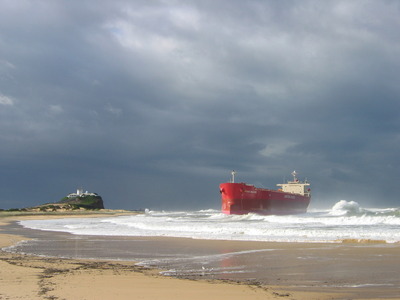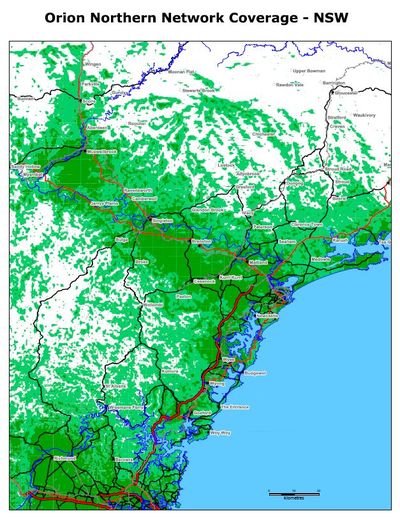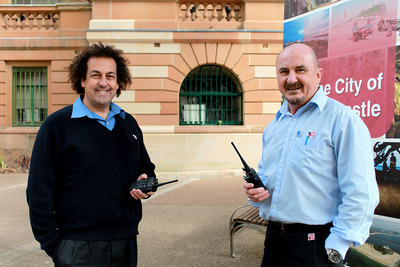CASE STUDY: Orion and the Newcastle City Council
For the city council of one of Australia’s largest cities, making the switch to digital is saving money and boosting productivity.
The city of Newcastle in New South Wales’s Hunter Valley region has had more than its fair share of disasters and incidents in recent years, beginning with the 1988 earthquake. Lately there have been floods and storms, and the grounding of the bulk carrier Pasha Bulker in 2007. All of these incidents required comprehensive emergency services responses, and that, of course, required a good communication system. But the Newcastle City Council’s system was old and becoming ineffective.
So, just as with many other councils and similar organisations, Newcastle found itself faced with a dilemma - how to maintain a functional communications network in the face of rapid technological and regulatory change. Specifically, how - and even whether - to replace analog equipment which in many cases was well past its use-by date, and also how to comply with ACMA’s narrow-banding changes.
“With the spectrum changes coming, we wouldn’t have been able to operate, because a lot of our old radios would not have worked under the new bandwidths,” said Peter Crotty, Newcastle City Council’s electrical projects coordinator. “We probably had around 300 radios, old analog things. We had heaps of different frequencies and licences, and different types of radios, so nothing was standard. And a lot of our infrastructure such as the aerials and the transmitters were in a pretty poor state. So we were more or less forced into doing something, or scrapping the radios altogether.”

So about two years ago the council began the process of investigating moving to a new digital system. “We first had to do an audit to find out where all the radios were, because we didn’t really know what we had out there,” said Crotty. “We did a lot of research and attended seminars and presentations to find out what we really needed. We went back to scratch and asked ourselves if we really wanted the two-way radios - did they still have a role to play? And it was decided they did, for lots of different reasons.”
And as luck would have it, a new digital radio network had just come online, and an enterprising local dealer was ready and waiting with a solution to the council’s needs. That solution was the Orion Network - very appropriately named, given that in Greek mythology, Orion is known as The Hunter.
The Orion Network
The Orion Network is deployed by a number of radio dealers around the country. It is built on Motorola’s MotoTRBO radio platform, all linked together over IP. The network segment in New South Wales north of the Hawkesbury River is owned and operated by Gencom.
At the time the Newcastle City Council was investigating options, Orion was already in place but had only just become operational. “We deployed the infrastructure and we own the sites in many cases, and we have site rental of the locations that we don’t own,” said Jason Mann of Gencom. “So it was only a matter of us putting in the equipment and putting in backhaul IP links to provide the coverage and connectivity with the rest of the network.
“We’ve had a few natural disasters up here in the recent past,” said Mann. “What has been learned from past disasters, particularly the Queensland and Brisbane floods, is that landline and mobile phone infrastructure is often amongst the first to fall over. Where councils in particular have moved to mobile phones, they’d either have no coverage and not be able to reach their people, or they’d have coverage but would be competing with the public making their own calls (often to council personnel). So they wouldn’t be able to get hold of their own people and do any command and control at all in times of disaster.
“So the proposal is that as more councils come aboard, we can actually create a disaster management group that spans across all these councils,” said Mann. “So if a flood were to happen on the Hunter River, which would affect, say, eight councils, then they could actually have a conduit to talk amongst themselves, independent of the telcos, independent of all the other solutions. And even if our towers went down, the radios can still talk amongst themselves.”

Gencom is one of only a small number of Platinum Partners for Motorola Solutions, authorised to sell all of Motorola’s high-end digital products across all their platforms. It’s also one of the few Orion partners that are Platinum Partners as well.
“We already owned several towers,” Mann added. “So it was just a case of putting in base station repeater equipment and linking them up and then trying to find clients to go on it. Newcastle City Council is a good example of that. We also have Busways and others, including Maitland Council, now also on the network.”
Gencom is also Motorola’s preferred minerals and energy partner in NSW, looking after mines in the Hunter Valley and Gunnedah Basin, the Ulan Basin and the Central West. “We’ve run our own radio networks for 20 or 30 years, in various different platforms,” said Mann. “We have two different digital networks; Orion is one, and definitely the flagship solution.”
Putting the radios to use
The council’s new radios - Motorola DP 3601 portable terminals and DM 3601 mobile terminals - are used by a wide range of staff, such as: beach staff, street sweepers, and parks and gardens staff; civil works, maintenance, construction and road workers; and in garbage collection trucks and waste management centres.
There’s also Blackbutt Reserve, which covers about 180 hectares and includes native animal exhibits. It’s a traditional mobile phone black spot, and staff can be at one end of it or the other over the course of a day. “Communications are a lot better and more reliable now with the two-ways,” said Kosta Flamiatos, council’s manager of road and asset maintenance services. “The Orion system gets in fine.”
The council does not have a communications centre. Rather, “we have three or four different base stations, and a number of talk groups set up for individual groups, plus there is the ability to go across the network to other groups”, said Crotty.


The benefits of Orion
The upgrade to the Orion network has brought a number of significant benefits (see list below). “With most of the features we knew what we would get,” said Crotty. “We basically bought the skeleton of what we need, and it’s something we can build on and add all the bells and whistles down the track.”
“We were looking for a reliable system, and something I suppose that would bring us more into the digital age, which is a huge plus on where we were coming from,” said Flamiatos. “We haven’t had any trouble with the Orion system at all. There have been efficiency improvements, such as better communication between the work areas, particularly if you’re coming and going within sites. We are looking at even potentially expanding within the depot to our stores staff - to give truck drivers coming in the ability to call them and say, ‘Can you be at this certain location?’, rather than having to park and walk over to speak with the stores staff.
“If some of our road workers are at the asphalt plant and they’re held up, they can call back to the work site and let them know,” added Flamiatos. “Or they can call and say ‘I’m on my way’ or ‘I’m this far away’, so the workers at the site can get prepped and ready to go. They can make better work decisions rather than waiting.”
“On our beaches we’re able to talk to the Westpac rescue helicopter, we can talk to the coastal patrol, and users can talk over the beach PA via their radios as well,” said Crotty. “These are things we had before, but they’ve been brought into the new digital system.
“The other thing we do have … when the guys are out on the jet skis, they wear a helmet with a radio so they can communicate back hands-free,” Crotty added.

“I think one of the other advantages has been the ability to communicate between non-traditional areas,” said Flamiatos. “For example, we might have some of our civil works guys doing some work at Blackbutt, and they can now communicate a lot better with the staff there - when they’re coming and going, what’s in the way and so on. Before it was a bit of hit and miss.”
Functions such as man down and duress are also highly valued. “There aren’t a lot of remote areas geographically in Newcastle, but workers can be remote from other workers,” added Flamiatos. “They’re good backups to have.”
One of the big pluses of the change to Orion was the fact that - unlike solutions from commercial telcos - it is a fixed-cost service, so the council can budget more effectively. “I think that was something that was attractive to the council, yes,” said Crotty. “By going down this digital track, we know what our ongoing costs are going to be.”
There are other advantages to staying clear of commercial telcos. “A radio system is purely a work tool and it’s rugged, robust. And the radios tend to last 10-15 years. So you can buy the equipment once, and you have absolutely fixed comms costs - you know exactly how much it’s going to cost every month,” said Mann. “Plus the ability to have GPS functionality, to see where your people are. You can potentially do things like report the locations of potholes and run a report from the radio network to tell the roadworks guys where the potholes are. There are all sorts of things possible when you have a digital network in place.”
If the spectrum rules hadn’t changed, would the switchover to digital still have happened anyway? “The ACMA changes certainly gave an impetus to make sure there was a decision made,” said Flamiatos. “It might not have been an all-encompassing change, but certainly for one of the areas I look after - our truck drivers and plant operators - we were looking to improve our system, because a lot of our units were failing. We needed something new.”
Where to now for Orion?
So where next for Orion in the Hunter region and beyond? “As mentioned, we also have Maitland City Council on the Orion network,” said Mann. “And we are in consultation with all the other councils in the Hunter Region - about a dozen of them - that are in various stages of consideration.
“Beyond the region, we’re also talking to many councils, and the Orion group presented last year at the LGMA (Local Government Managers Association) annual conference in Hobart about the benefits of this network throughout the country,” added Mann. “A lot of interest was generated by this, and we expect to see further councils take advantage of all the benefits of the Orion digital radio network in the months and years ahead.”
******************************
Newcastle City Council’s Orion implementation:
- Compliance with ACMA narrow-banding requirements
- Vastly improved audio quality compared to analog
- Coverage across local government area
- Fixed communications cost, no additional charges for variable talk times or volume of traffic
- Secure communications
- Voice and data logging
- GPS location of terminals
- Seamless roaming from across radio cells
- Fully managed and maintained infrastructure
- One-to-many communications (group call)
- One-to-one communications (individual call)
- Lone- and remote-worker management
- Radio ID display on transmissions
- Ability to intercommunicate with external legacy UHF analog radio systems in use with partners and contractors
- Over-the-air reprogramming of terminals removing the need to return terminals to the workshop for reprogramming
- Software capability expansion without the need to change infrastructure or terminal hardware
******************************
Wireless networks for mine management
Today's fleet management applications form the foundation for a future where driverless...
Wireless networks for mine management
Today's fleet management applications form the foundation for a future where driverless...
Interoperability for Tasmania's emergency services
Tasmanian police, fire and ambulance services can now communicate directly with each other,...



